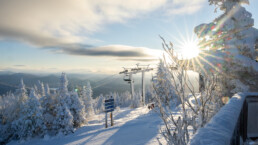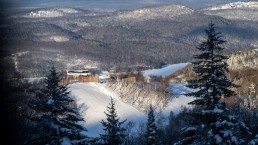Many factors influence snow production leading into the ski season, and they can vary widely from one year to the next. Even within a single day, conditions can shift quickly. Today, delivering a high-quality skiing experience relies on a dedicated team whose expertise has grown over the years. Their work is rooted in increasingly precise planning and an impressive ability to adapt to ever-changing conditions. For several years now, the opening of the ski area has depended largely on snowmaking. As soon as the first cold spells arrive in the fall, our systems are activated.
A Proactive Approach to Ensuring Snow
Our teams are proactive and constantly monitoring the weather. They prepare equipment according to forecasts to make the most of every snowmaking opportunity on the mountain. For example, depending on wind direction, they adjust snow canon locations, and when temperatures drop suddenly, their ability to start the system quickly can make all the difference. We also continually explore new technologies and invest in energy-efficient infrastructure.
Temperature, humidity, and wind are the main factors that influence snowmaking. Higher humidity requires colder temperatures to produce snow, which is common early in the season when Lake Tremblant has not yet frozen. New-generation snow guns can operate at higher temperatures while using less compressed air, though production is significantly greater when the air is colder. Other factors also determine whether a cold window can be fully used. Before starting production, our teams consider the risk of upcoming rain, strong winds, or a rapid warm-up.

Carefully Managing Water and Energy
At Tremblant, the water used for snowmaking is borrowed from nature: it comes from Lake Tremblant and the Diable River, then returns to those same sources with the spring melt. It is not drinking water, and nothing about the process is artificial. The snow is simply created by mixing water and compressed air in optimal conditions, around -5°C.
This practice is regulated under the Environmental Quality Act and the Regulation Respecting Activities Carried Out in Connection with Their Impact on the Environment (REAFIE). We ensure that all required authorizations are met and that water volumes are reported in accordance with Ministry of the Environment requirements.
With rigorous planning and advanced technologies—automated systems and next-generation snow guns—we optimize every liter of water and energy used. Our network operates entirely on hydroelectricity, a clean, renewable source, and the water is drawn at a time of year when other uses, such as agriculture, have ended.
At Tremblant, snowmaking is above all about managing water responsibly, in a way that respects nature and the cycle that connects us to the mountain.
A Collective Commitment to Protect Winter
According to Tremblant’s Director of Sustainable Development, Nathalie Dandoy:
“Tremblant has already demonstrated strong initiative in researching and implementing eco-responsible solutions to help future generations enjoy the same pleasures we have today. But experts are clear about the urgency of reducing greenhouse gas emissions, and each of us has the responsibility to take action without delay. Every action counts, and we encourage our guests, employees, suppliers, partners, and community to demonstrate real commitment and get involved to ensure the joys of winter last for a very long time.”
Eco-Responsible Initiatives at Tremblant
For more than 20 years, Tremblant has been taking concrete actions to promote eco-responsible practices across all areas of operation. Numerous initiatives have been implemented in the circular economy—including waste reduction—sustainable mobility such as transport electrification, responsible tourism, community support, and climate innovation, particularly in energy efficiency.
Tremblant is committed to continuing these efforts to protect the environment and support a sustainable future for skiing, so that generations to come can continue to enjoy the mountain and the beauty of winter.
See our major achievements









